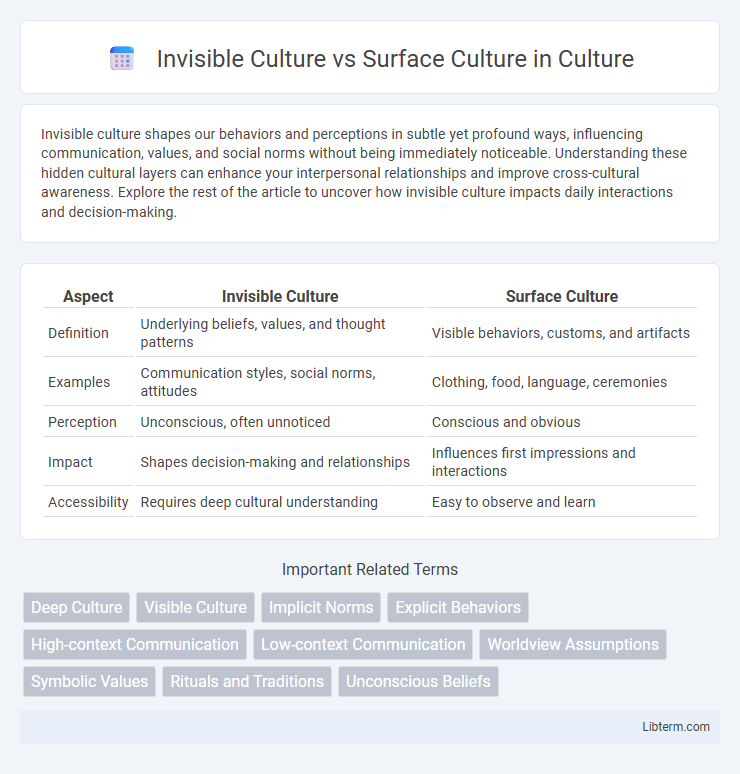Invisible culture shapes our behaviors and perceptions in subtle yet profound ways, influencing communication, values, and social norms without being immediately noticeable. Understanding these hidden cultural layers can enhance your interpersonal relationships and improve cross-cultural awareness. Explore the rest of the article to uncover how invisible culture impacts daily interactions and decision-making.
Table of Comparison
| Aspect | Invisible Culture | Surface Culture |
|---|---|---|
| Definition | Underlying beliefs, values, and thought patterns | Visible behaviors, customs, and artifacts |
| Examples | Communication styles, social norms, attitudes | Clothing, food, language, ceremonies |
| Perception | Unconscious, often unnoticed | Conscious and obvious |
| Impact | Shapes decision-making and relationships | Influences first impressions and interactions |
| Accessibility | Requires deep cultural understanding | Easy to observe and learn |
Defining Invisible and Surface Culture
Surface culture consists of visible elements like language, clothing, food, and customs that are easily observed in everyday interactions. Invisible culture encompasses deep-seated values, beliefs, thought patterns, and social norms that influence behavior beneath the surface and remain unconscious to outsiders. Understanding both dimensions is essential for effective cross-cultural communication and reducing misunderstandings.
Key Elements of Surface Culture
Surface culture includes observable aspects such as language, clothing, food, rituals, and technology, which are easily seen and recognized in daily interactions. These elements serve as the tangible expressions of a society's identity and customs, providing immediate clues about cultural norms and values. Understanding surface culture helps facilitate initial cross-cultural communication but requires deeper exploration of invisible culture for full comprehension.
Understanding the Depths of Invisible Culture
Invisible culture encompasses underlying values, beliefs, and thought patterns that shape behavior and perceptions beyond observable actions, contrasting with surface culture's visible elements like language, dress, and customs. Understanding the depths of invisible culture requires analyzing core dimensions such as communication styles, social norms, attitudes toward authority, and concepts of time and space inherent in different societies. Mastery of these intangible cultural elements enhances cross-cultural competence by revealing motivations behind surface behaviors and facilitating deeper interpersonal connections.
Examples of Surface Culture in Everyday Life
Surface culture encompasses visible aspects of culture such as language, clothing, food, rituals, and art that are easily observed in everyday life. Common examples include traditional dress, holiday celebrations, music genres, culinary preferences, and social customs like greetings and table manners. These tangible elements provide immediate cultural cues, distinguishing one culture's external expressions from the underlying invisible values, beliefs, and thought patterns.
Hidden Influences of Invisible Culture
Invisible culture encompasses hidden influences such as beliefs, values, norms, and thought patterns that shape behavior and social interactions beneath the surface. These intangible elements impact decision-making, communication styles, and conflict resolution, often going unnoticed in cross-cultural exchanges. Understanding invisible culture is crucial for effective intercultural competence and avoiding misunderstandings in diverse environments.
The Interplay Between Surface and Invisible Culture
Surface culture includes observable behaviors, customs, language, and traditions that are easily identified in social interactions. Invisible culture encompasses underlying values, beliefs, thought patterns, and perceptions that shape how individuals interpret the world and behave. The interplay between surface and invisible culture influences communication effectiveness, conflict resolution, and adaptation in multicultural environments by revealing how deeper cognitive frameworks impact visible cultural expressions.
Challenges in Recognizing Invisible Culture
Invisible culture encompasses deep-rooted values, beliefs, and thought patterns that shape behaviors unconsciously, making them difficult to identify and address. Challenges in recognizing invisible culture include overcoming ethnocentrism, limited self-awareness, and communication barriers that obscure underlying cultural assumptions. Effective intercultural competence requires deliberate efforts to explore these hidden dimensions through reflection, open dialogue, and context-sensitive analysis.
Surface Culture in Global Communication
Surface culture encompasses visible elements such as language, customs, dress, and social behaviors that are easily observed in global communication settings. These tangible aspects serve as entry points for intercultural interaction, facilitating initial understanding and rapport across diverse cultural groups. Effective global communication relies on recognizing and appropriately responding to these surface culture cues to avoid misunderstandings and build trust.
Impact of Invisible Culture on Identity
Invisible culture, encompassing values, beliefs, and thought patterns, profoundly shapes individual and group identities by influencing perceptions and behaviors beyond observable customs. This deep-seated layer of culture affects how people interpret social interactions and form a sense of belonging, often dictating unspoken rules and internal motivations. Understanding invisible culture is essential for recognizing the root causes of identity formation and intercultural communication challenges.
Bridging the Gap: Navigating Both Culture Types
Understanding invisible culture--values, beliefs, and thought patterns--alongside surface culture, such as language, customs, and dress, is crucial for effective cross-cultural communication. Bridging the gap requires developing cultural intelligence and empathy to recognize unspoken norms while respecting visible cultural expressions. Practical strategies include active listening, open-minded observation, and continuous learning to navigate complexities and foster meaningful intercultural connections.
Invisible Culture Infographic

 libterm.com
libterm.com